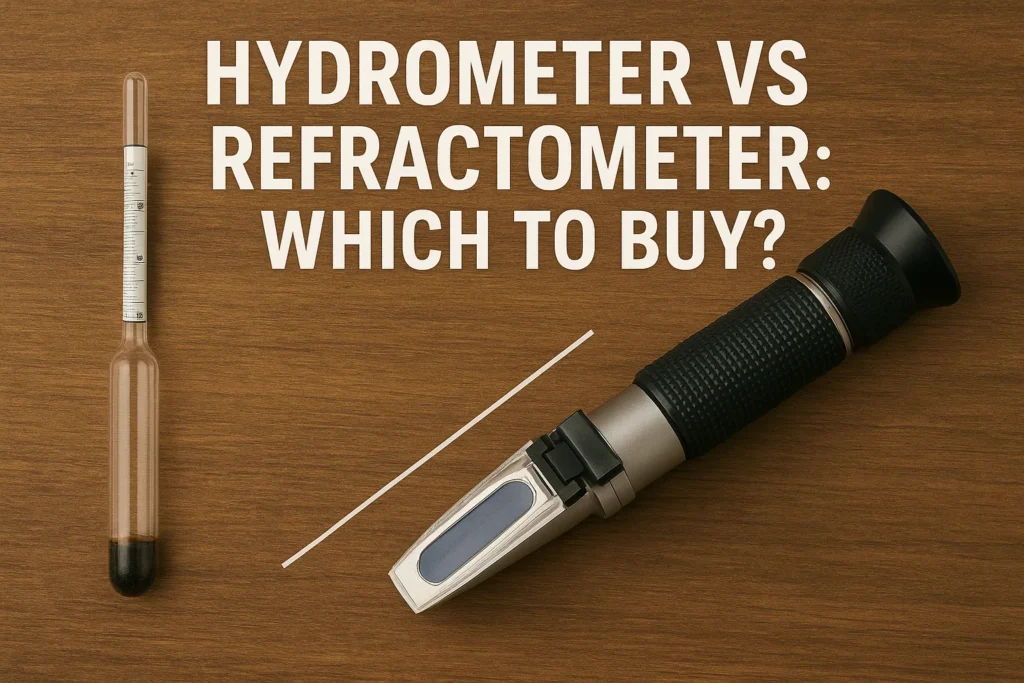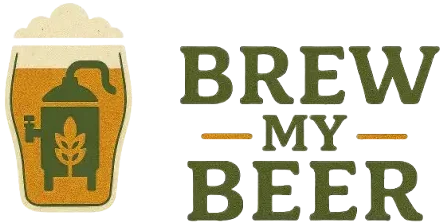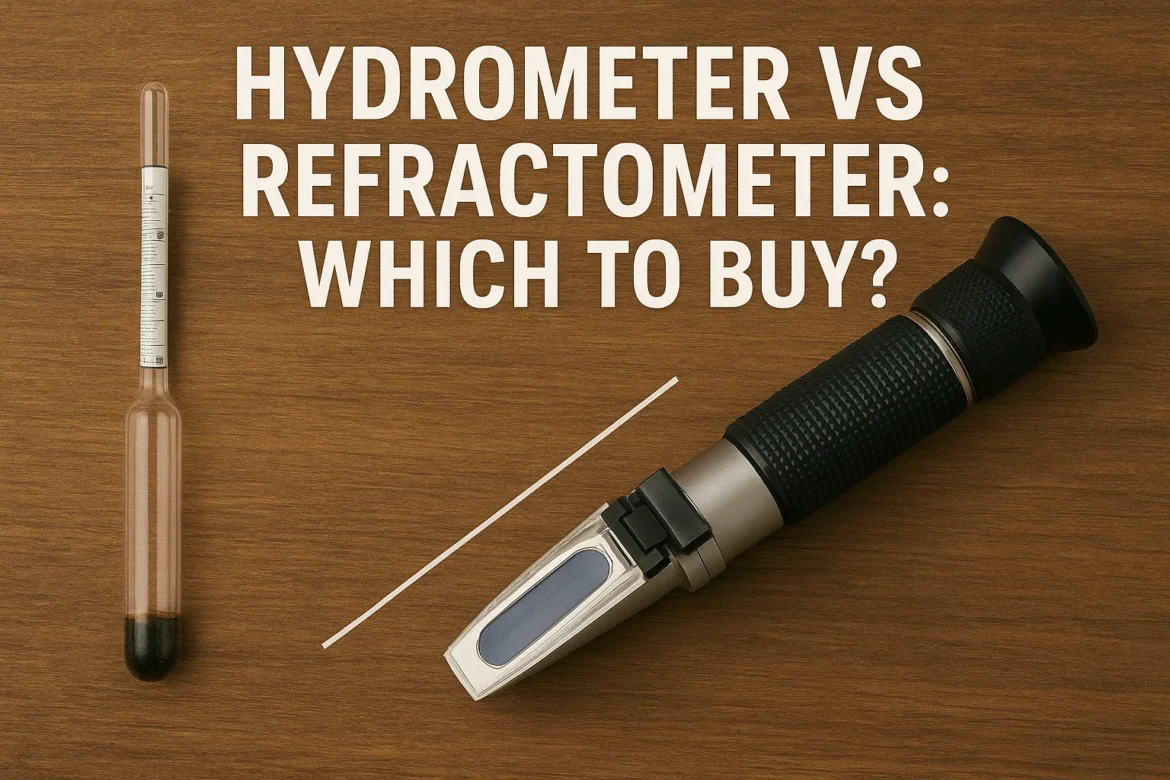Compare hydrometer vs refractometer for brewing with our detailed analysis. Discover accuracy, cost, ease of use, and practical applications to determine which gravity measurement tool best suits your homebrewing needs and budget.

The choice between a hydrometer and refractometer represents one of the most fundamental decisions every serious brewer faces, affecting not just measurement accuracy but workflow efficiency and long-term brewing success. After fifteen years of brewing and using both instruments extensively across hundreds of batches, I can confidently state that understanding the strengths and limitations of each tool is crucial for making an informed decision that aligns with your brewing goals and practices.
My measurement journey began with a basic triple-scale hydrometer that served faithfully for years before I discovered the convenience and precision of refractometry. The transition revealed advantages and limitations I never anticipated, leading to a deeper understanding of when each tool excels and why many experienced brewers ultimately use both instruments for different applications.
This comprehensive comparison examines every aspect of hydrometers versus refractometers, analyzing performance through systematic testing, practical brewing scenarios, and detailed evaluation of accuracy, convenience, and value. From measurement principles to real-world applications, understanding these instruments’ capabilities ensures your investment delivers consistent results while supporting your brewing development.
Whether you’re starting your brewing journey or reconsidering existing measurement practices, choosing the right gravity measurement tool affects every batch you produce, influencing fermentation monitoring, recipe development, and the overall brewing knowledge that elevates your craft.
Understanding Gravity Measurement Principles
Both hydrometers and refractometers measure specific gravity through fundamentally different mechanisms that affect their accuracy, convenience, and optimal applications. Understanding these principles guides intelligent selection based on specific brewing requirements.
Hydrometer Density Measurement
Hydrometers measure liquid density by floating in the sample and indicating specific gravity based on buoyancy principles. The depth to which the instrument sinks correlates directly to liquid density, with graduated scales providing specific gravity readings that remain consistent regardless of dissolved substances.
Refractometer Optical Measurement
Refractometers measure refractive index through light bending as it passes through liquid samples. The refractive index correlates with dissolved solids concentration, enabling specific gravity calculation through established conversion formulas.
Temperature Effects and Compensation
Both instruments are affected by temperature variations, though they respond differently. Hydrometers typically include correction tables for temperature adjustment, while quality refractometers incorporate Automatic Temperature Compensation (ATC) that provides corrected readings automatically.
Sample Volume Requirements
The fundamental difference in sample requirements affects practical usage significantly. Hydrometers require 200-250ml samples for proper flotation, while refractometers need only 2-3 drops, creating dramatic differences in sample waste and contamination risk.
Accuracy and Precision Characteristics
Both instruments can achieve excellent accuracy when properly calibrated and used correctly, though their precision characteristics differ based on construction quality, calibration maintenance, and operator technique.
Hydrometer Analysis: Traditional Reliability
Hydrometers represent the traditional approach to gravity measurement, offering proven reliability, cost-effectiveness, and straightforward operation that has served brewers effectively for generations.
Construction and Design Features
Quality hydrometers feature precision-blown glass construction with weighted bottoms and calibrated scales that provide accurate density measurements. The triple-scale design includes specific gravity, potential alcohol, and Brix scales for comprehensive measurement capability.
Accuracy and Measurement Range
Hydrometers typically provide accuracy within ±0.002 specific gravity units when properly calibrated and used at correct temperatures. The measurement range covers all brewing applications from light beers (1.020) to strong ales and barleywines (1.120+).
Ease of Use and Learning Curve
Hydrometer operation is intuitive requiring minimal learning curve for new brewers. The visual scale reading and direct specific gravity display eliminate complex calculations or conversion factors that might confuse beginners.
Cost and Value Proposition
Quality hydrometers cost $10-25, making them highly accessible for beginning brewers. The low initial investment enables immediate gravity measurement capability without significant financial commitment.
Fermentation Monitoring Excellence
Hydrometers excel during fermentation monitoring because alcohol content doesn’t affect measurement accuracy. This advantage becomes crucial for tracking fermentation progress and determining final gravity accurately.
Limitations and Challenges
Large sample requirements waste valuable wort and finished beer while increasing contamination risks. The glass construction creates fragility concerns, and temperature corrections require additional calculations for accuracy.
Hydrometer vs Refractometer Refractometer Evaluation: Modern Precision
Refractometers represent advanced measurement technology, offering superior convenience and precision through optical measurement principles that revolutionize brewing workflow efficiency.
Optical System and Construction
Quality refractometers feature precision optical systems with temperature compensation mechanisms that provide accurate readings across varying environmental conditions. The daylight plate design enables clear scale reading under various lighting conditions.
Sample Efficiency and Waste Reduction
The minimal sample requirement (2-3 drops) virtually eliminates wort waste while reducing contamination risks significantly. This efficiency particularly benefits all-grain brewers monitoring mash runoff and boil gravity throughout the process.
Speed and Convenience Advantages
Refractometer readings take 15-30 seconds compared to several minutes for hydrometer stabilization. The rapid measurement capability streamlines brewing workflow while enabling frequent monitoring without significant time investment.
Temperature Compensation Benefits
Automatic Temperature Compensation eliminates manual correction calculations, providing accurate readings regardless of sample temperature. This feature particularly benefits outdoor brewing or temperature-variable environments.
Build Quality and Durability
Metal construction provides superior durability compared to glass hydrometers, reducing breakage concerns during transport and field use. Quality refractometers withstand demanding brewing environments while maintaining calibration accuracy.
Post-Fermentation Limitations
Alcohol presence interferes with refractometer readings, requiring correction calculations or dedicated brewing refractometers with dual scales. This limitation affects final gravity accuracy and fermentation monitoring applications.
| Measurement Tool | Sample Volume | Reading Time | Temperature Sensitivity | Durability | Initial Cost |
|---|---|---|---|---|---|
| Hydrometer | 200-250ml | 2-3 minutes | Requires correction | Fragile glass | $10-25 |
| Refractometer | 2-3 drops | 15-30 seconds | Auto compensation | Durable metal | $40-150 |
Accuracy and Precision Comparison
Understanding the accuracy and precision characteristics of both instruments guides selection based on measurement requirements and quality expectations for specific brewing applications.
Laboratory Testing Results
Controlled testing reveals both instruments achieve comparable accuracy when properly calibrated and operated under optimal conditions. Hydrometers typically provide ±0.002 SG accuracy while quality refractometers achieve ±0.0005 SG precision.
Real-World Performance Factors
Practical accuracy depends heavily on operator technique, calibration maintenance, and environmental conditions. Hydrometers require steady hands and accurate meniscus reading, while refractometers need proper sample preparation and optical cleanliness.
Temperature Effect Analysis
Temperature variations affect both instruments differently. Hydrometers show linear temperature effects with predictable corrections, while refractometers with ATC provide consistent accuracy across temperature ranges without manual calculations.
Calibration Stability and Maintenance
Hydrometers maintain calibration indefinitely unless physically damaged, while refractometers may require periodic recalibration or verification against known standards to maintain accuracy over time.
Operator Error and Technique Impact
Hydrometer accuracy depends on proper flotation, meniscus reading, and temperature correction. Refractometer accuracy requires clean optics, proper sample application, and adequate lighting for scale reading.
Cost Analysis and Value Assessment
Understanding total ownership costs including initial investment, accessories, and replacement considerations helps optimize instrument selection based on budget constraints and usage patterns.
Initial Purchase Price Comparison
Basic hydrometers cost $10-25 while quality refractometers range $40-150, creating significant initial investment differences. The cost differential reflects manufacturing complexity and precision requirements.
Required Accessories and Support Equipment
Hydrometers require test jars ($5-15) and potentially thermometers for temperature correction. Refractometers include all necessary components but may benefit from calibration solutions ($10-20) for accuracy verification.
Long-Term Replacement Costs
Glass hydrometers require eventual replacement due to breakage, while quality refractometers provide years of reliable service with proper care. Consider expected service life when evaluating total ownership costs.
Sample Waste Economic Impact
Hydrometer sample requirements create ongoing costs through wort and beer waste, particularly significant for small-batch brewers or expensive ingredient recipes. Refractometer efficiency eliminates waste-related costs.
Professional vs. Hobby Value Propositions
Commercial brewers justify refractometer costs through efficiency gains and waste reduction, while hobby brewers may find hydrometers provide adequate performance at accessible pricing.
For comprehensive brewing measurement techniques and advanced gravity monitoring strategies, explore the detailed resources at BrewMyBeer’s measurement guides, where professional brewing precision meets practical homebrewing applications.
Practical Applications and Workflow Integration
Understanding how each instrument integrates into different brewing workflows guides selection based on specific brewing styles, batch sizes, and operational requirements.
All-Grain Brewing Applications
All-grain brewers benefit significantly from refractometer efficiency during mash monitoring, sparge gravity verification, and boil progression tracking. The minimal sample requirement enables frequent testing without significant volume loss.
Extract and Partial-Mash Integration
Extract brewers typically perform fewer gravity measurements, making hydrometer cost-effectiveness more attractive. The larger sample volumes represent smaller percentages of total batch size in extract brewing scenarios.
Fermentation Monitoring Strategies
Hydrometers excel during fermentation because alcohol doesn’t affect readings, providing accurate progress tracking and final gravity determination. Refractometers require correction calculations or dual-scale instruments for fermentation monitoring.
Small-Batch and Experimental Brewing
Small-batch brewers particularly benefit from refractometer efficiency, where 200ml hydrometer samples represent significant portions of total volume. The minimal waste enables more frequent monitoring and tighter process control.
Commercial and Professional Applications
Professional brewers typically use both instruments strategically: refractometers for process control and efficiency, hydrometers for final gravity verification and quality control documentation.
Specific Brewing Scenario Analysis
Different brewing scenarios favor specific instruments based on measurement requirements, workflow constraints, and accuracy priorities that affect optimal tool selection.
High-Gravity Beer Production
High-gravity brewing benefits from refractometer efficiency during extended boils and concentration monitoring. However, final gravity determination requires hydrometer accuracy due to alcohol interference challenges.
Session Beer and Low-Gravity Applications
Low-gravity beers require precise measurement for proper attenuation calculation and alcohol content determination. Both instruments perform well in this range, though hydrometer simplicity may appeal to casual brewers.
Fruit and Specialty Ingredient Integration
Specialty ingredients may affect refractometer readings through optical interference or unusual refractive properties. Hydrometers provide consistent density measurement regardless of ingredient complexity.
Outdoor and Mobile Brewing
Refractometer durability and minimal sample requirements excel in outdoor brewing environments where glass breakage and large sample handling present challenges. Temperature compensation eliminates correction calculations.
Quality Control and Documentation
Professional quality control programs may require both instruments for comprehensive measurement verification and documentation requirements that support regulatory compliance and consistency standards.
Advanced Features and Technology Integration
Modern instruments incorporate advanced features that enhance accuracy, convenience, and integration with digital brewing systems and quality control programs.
Automatic Temperature Compensation
ATC refractometers automatically adjust readings for temperature variations, eliminating manual correction calculations while ensuring consistent accuracy across environmental conditions.
Digital Display Integration
Digital refractometers provide precise numerical readings that eliminate visual interpretation errors while enabling data logging and integration with brewing software systems.
Dual-Scale Brewing Refractometers
Specialized brewing refractometers include both pre-fermentation and post-fermentation scales that account for alcohol interference, providing accurate readings throughout the brewing process.
Precision Hydrometer Options
Laboratory-grade precision hydrometers offer enhanced accuracy and narrow measurement ranges for critical applications requiring maximum precision and repeatability.
Smart Technology Integration
Emerging digital instruments integrate with smartphone apps and brewing software for automatic data logging, trend analysis, and recipe optimization capabilities.
Maintenance and Calibration Requirements
Proper maintenance ensures optimal performance while extending instrument life and maintaining accuracy throughout extended service periods.
Hydrometer Care and Storage
Glass hydrometers require careful handling and appropriate storage to prevent breakage. Regular cleaning with appropriate solutions maintains accuracy while preventing contamination or residue buildup.
Refractometer Maintenance Procedures
Refractometer maintenance focuses on optical cleanliness and calibration verification. Regular cleaning of the daylight plate and prism ensures accurate readings while protecting delicate optical surfaces.
Calibration Verification and Adjustment
Both instruments benefit from periodic calibration verification using distilled water or certified reference solutions. This verification ensures continued accuracy and identifies degradation requiring correction.
Storage and Environmental Protection
Proper storage protects instruments from temperature extremes, physical damage, and contamination that could affect accuracy or functionality during extended service periods.
Replacement and Upgrade Considerations
Understanding wear patterns and performance degradation guides replacement timing and upgrade decisions that maintain measurement quality throughout brewing operations.
Troubleshooting Common Issues
Understanding typical problems and solutions prevents measurement errors while ensuring consistent performance from both instrument types across different brewing applications.
Hydrometer Reading Difficulties
Common issues include meniscus interpretation errors, temperature correction mistakes, and flotation problems. Systematic techniques and proper equipment setup resolve most accuracy challenges.
Refractometer Optical Problems
Optical issues including fogging, sample contamination, and lighting problems affect reading accuracy. Understanding proper sample preparation and optical maintenance prevents most operational issues.
Calibration Drift and Correction
Both instruments may experience calibration drift over time. Regular verification and appropriate correction procedures maintain accuracy while identifying instruments requiring service or replacement.
Temperature-Related Accuracy Issues
Temperature effects impact both instruments differently. Understanding compensation requirements and proper technique ensures accurate readings across varying environmental conditions.
Sample Preparation and Technique Optimization
Proper sample preparation, handling technique, and reading procedures maximize accuracy while preventing contamination and operational problems that affect measurement reliability.
Making the Decision: Which Instrument to Choose
The choice between hydrometer and refractometer depends on individual brewing priorities, budget constraints, and operational requirements rather than universal superiority of either instrument.
Budget-Conscious Brewing Operations
New brewers with limited budgets achieve excellent results with quality hydrometers that provide accurate measurements at accessible pricing. The proven reliability and simplicity support successful brewing development.
Efficiency and Convenience Priorities
Brewers prioritizing efficiency and convenience benefit significantly from refractometer investments that reduce waste, accelerate measurements, and eliminate temperature correction calculations.
Professional and Commercial Applications
Commercial operations typically justify refractometer costs through efficiency gains and quality control benefits, though many professional brewers maintain both instruments for comprehensive measurement capability.
Hybrid Approach Benefits
Many experienced brewers use both instruments strategically: refractometers for process monitoring and efficiency, hydrometers for final gravity verification and fermentation tracking.
Future Growth and Development
Consider anticipated brewing development and technique advancement when selecting instruments. Quality refractometers support advanced brewing techniques while hydrometers provide foundational measurement capability.
Final Recommendations
Both hydrometers and refractometers offer legitimate advantages for different brewing applications, with optimal selection depending on specific requirements, priorities, and operational constraints rather than universal superiority.
For beginning brewers seeking reliable, cost-effective measurement capability, a quality triple-scale hydrometer provides excellent value and proven performance that supports brewing development while remaining accessible and straightforward to use.
Efficiency-focused brewers benefit significantly from refractometer investments that reduce waste, accelerate measurements, and support advanced brewing techniques through superior convenience and precision capabilities.
Many experienced brewers ultimately acquire both instruments, using them strategically for different applications: refractometers for original gravity and process monitoring, hydrometers for final gravity and fermentation verification.
Consider your brewing frequency, budget constraints, and efficiency priorities when making selection decisions. Both instruments can deliver excellent results when properly selected, calibrated, and maintained according to their specific requirements.
The investment in quality measurement equipment pays dividends through improved brewing consistency, better process control, and enhanced understanding of brewing science that elevates your craft and results.
Choose the instrument that best matches your current needs while considering future brewing development and technique advancement that may influence long-term equipment requirements and capabilities.
About the Author:
John Brewster is a passionate homebrewer with over a decade of experience experimenting with different beer styles. After working at three craft breweries and winning several regional homebrew competitions, John now dedicates his time to developing innovative recipes and teaching brewing techniques. His specialty lies in creating unique flavor profiles by combining traditional brewing methods with unexpected ingredients. When not tending to his five fermenters, John enjoys pairing his creations with artisanal cheeses and hosting tasting sessions for friends and family.

